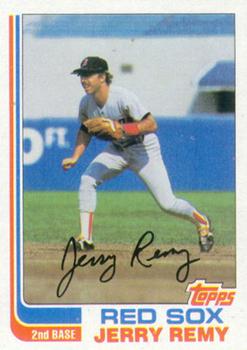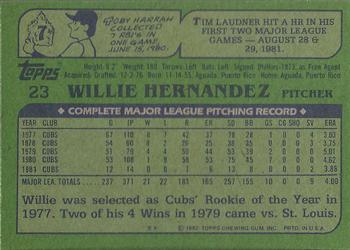Who Can It Be Now?
Dwayne Keith Murphy was born on March 18, 1955, in Merced, California. He attended Antelope Valley High School in Lancaster, California, and graduated in 1973. According to his still-available biography on the Toronto Blue Jays website, Murphy had an offer to play football at Arizona State University but chose instead to play baseball. He was drafted straight out of high school by the Oakland A's in the 15th round of the 1973 June Amateur Draft as the only player of any baseball value in that round.
It took Murphy a little while to find his feet in professional baseball, as he spent 3 seasons in A-league ball from 1973 through 1975. In fairness, Murphy was always young for each of those leagues, so the fact that, as a 20-year-old, he hit .291 with a .400 OBP at Modesto in the California League in 1975 was a good sign that the A's had a real player in Murphy. At every stop in the minors, Murphy walked more than he struck out and had excellent on-base skills.
Murphy made it to the major leagues in 1978, a year in which he served as a late-inning defensive replacement, a pinch hitter, and a pinch runner for the most part from April through June and again from July through August. He struggled with the limited playing time, but he never went back to the minor leagues after 1978 until he was on the downside of his career in 1988.
In 1980, Murphy had one of his best seasons as a hitter in the major leagues, and he won the first of his six straight Gold Gloves. He hit for his highest batting average that year, got on base at a .384 clip, and slugged .380. He hit 13 home runs and stole 26 bases.
That was the year that Billy Martin took over as manager of the A's. Billy Ball had taken hold in Oakland, meaning that the young pitching staff threw ridiculous amounts of innings and complete games -- 94 in total, which was 46 more than second place Milwaukee's 48. Murphy's defense in center field helped that club to an 83-79 record.
The pitching staff could throw flyballs all day, though, due to the incredible outfield that the A's had put together. That outfield consisted of the 25-year-old Murphy, a 21-year-old Rickey Henderson and 26-year-old Tony Armas. Together, they totaled 62 fielding runs above average -- an impressive total that, by itself, was a total of 4.1 wins above replacement. Add in their respective offensive WAR -- Murphy at 4.5, Henderson at 6.9, and Armas at 3.5 -- and you have an outfield that was 21.6 Wins above a replacement outfield.
Murphy's best offensive year on overall surface stats might have been his 1982 year. Despite a .238 batting average, he still carried a .349 OBP while hitting 27 homers, driving in 94, and stealing 26 against only 8 times caught. As he got older, though, he stopped taking as many walks -- likely because he was not seeing pitch outs by the opposing team to stop Rickey Henderson from stealing second or third base.
Staying in Oakland until 1987 thanks to a 4-year, $3.375 million contract signed in 1983 and a $759,000 contract in 1987, Murphy found himself unable to reach a deal with Oakland after two straight seasons in which he did not top 100 games played -- due, in large part, to injuries. In 1986, he ruptured a disk in his back in a violent collision with a wall in Fenway Park. Then, in 1987, he had to have knee surgery after colliding with Mike Davis.
Murphy left Oakland after the 1987 season and signed with Detroit. He found himself in the undesirable position of being 33 years old and spending half a season in Triple-A at Toledo. He was released at the end of spring training in 1989 and caught on with the Philadelphia Phillies for that season before calling it a career in America at the end of that season.
He finished his playing career in 1990 with 34 games for the Yakult Swallows where, no surprise, he hit for a poor average but got on base at a tremendous rate.
After retiring from baseball, Murphy coached high school football during the 1990s before joining up with the Arizona Diamondbacks organization. He stayed with the Diamondbacks from the time that they began in the National League until 2005, when the Toronto Blue Jays hired him as their minor league hitting instructor. In 2008, he was named first base coach for the Jays, and then became the hitting coach in 2010. He went back to first base coaching in 2013 before informing the Blue Jays that after 2013 and at the age of 59, he wanted a break from the day-to-day grind of Major League Baseball.
The Verdict
I know -- another category. But even if this category does not get used again, it's a good one here. The Paul Newman courtroom drama was based on a screenplay by David Mamet. It received five Academy Awards nominations, including Best Picture (which went to Gandhi over E.T., Missing, Tootsie, and The Verdict).
People familiar with MC Hammer know that Hammer was a batboy for the Oakland A's and it was his resemblance to Hank Aaron that got him the nickname "Little Hammer." Hammer a/k/a Stanley Burrell served as a batboy for the A's from 1973 through 1980. He was struggling in small venues as a rapper in the mid-1980s when he hit up a couple of his pals from his days as a batboy -- Outfielder Mike Davis and Outfielder Dwayne Murphy. Wikipedia provides a dead-link citation to a 1990 article in Ebony magazine to state that Davis and Murphy each loaded Hammer $20,000 to start his record label called Bust It Production.
A law firm which apparently was involved somehow archived a People Magazine article about the way that this business relationship was resolved. Murphy is quoted in the article from 1990 as saying that "[a]fter I saw him dancing I thought maybe it would work." Each ballplayer signed a contract with Hammer saying that they would each get 10% of all royalties, endorsements, concerts, promotions, and other monies in perpetuity. The $40,000 was not enough, so the players agreed to take out another $125,000 as a loan from a bank to support Hammer. In return, they thought they had an oral agreement for each to receive 15% of Hammer's incoming money.
Hammer did not pay the players money back, and unsurprisingly the bank wanted its $125,000 back. Murphy claimed that Hammer refused to pay any part of his revenues from his career to them, and that Hammer screamed at them that he would "rather pay an attorney a million dollars before I pay you a dime." Lawyers love clients like this.
They eventually settled, but not before Davis almost lost his Los Angeles home as a result.
A Few Minutes with Tony L.
Dwayne Murphy was a great supporting player for the Oakland A's in the early 1980s. When he stepped to the plate, he changed his approach depending on whether Rickey Henderson was on base or not. As a Brewers fan, I was never happy to see Murphy at bat. He feasted on Milwaukee pitching, hitting more home runs, stealing more bases, and having a better OBP and SLG against the Brewers than he did against any other American League team.
As the Blue Jays biography for Murphy stated, he turned down the opportunity to play football at Arizona State to pursue his baseball career. While that sounds all romantic and warm and fuzzy, Murphy's reality was harsher: as the Los Angeles Times article about him from 1994 noted, Murphy had married his junior high school sweetheart, Brenda, immediately after high school, and, even before he graduated high school, Dwayne and Brenda had a Dwayne Jr. to care for. He chose getting a job in baseball over a college scholarship because he pretty much felt he had to do it.
Some today might say that it was a real shame that Murphy had to forego his opportunity in the sport he truly loved -- football. To me, though, Murphy is a person whose story could serve as a true guidepost to follow: he was not concerned only about himself and what he "wanted" but instead stepped up, was responsible, and did what was best for his family.
Also, he provides the key lesson in life that Samuel Goldwyn of MGM fame provided: "A verbal contract isn't worth the paper it's written on."
Wise words to live by.

















